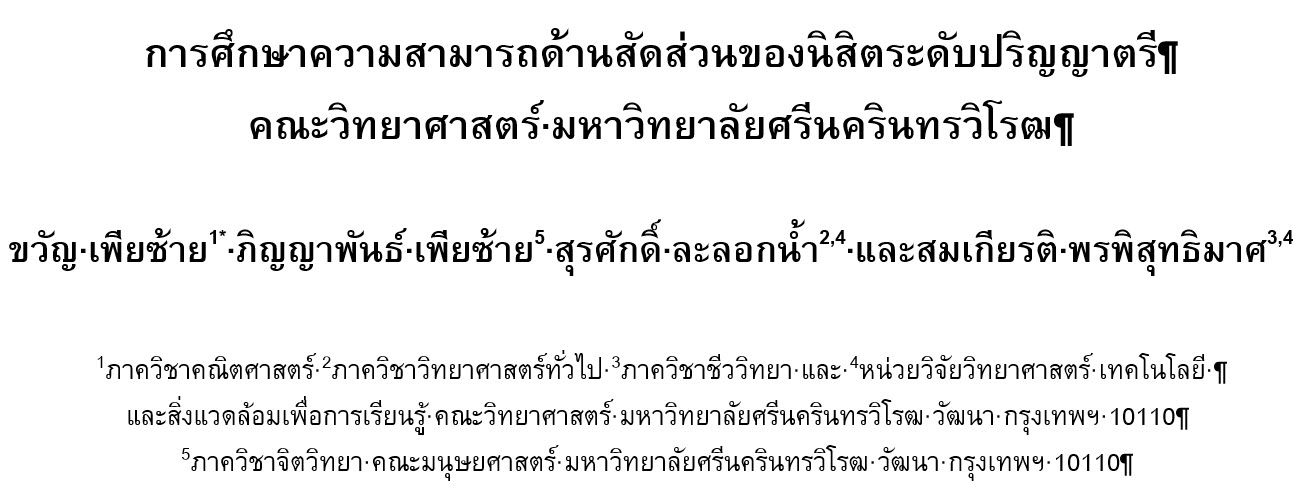การศึกษาความสามารถด้านสัดส่วนของนิสิตระดับปริญญาตรี คณะวิทยาศาสตร์ มหาวิทยาลัยศรีนครินทรวิโรฒ
Main Article Content
Abstract
Khawn Piasai, Pinyapan Piasai, Surasak laloknam and Somkiat Phornphisutthimas
รับบทความ: 11 ตุลาคม 2556; ยอมรับตีพิมพ์: 24 พฤศจิกายน 2556
บทคัดย่อ
งานวิจัยนี้มีวัตถุประสงค์เพื่อศึกษาความสามารถด้านสัดส่วนของนิสิตระดับปริญญาตรี คณะวิทยาศาสตร์ มหาวิทยาลัยศรีนครินทรวิโรฒ กลุ่มตัวอย่างเป็นนิสิตระดับปริญญาตรีชั้นปีที่ 3 ที่ศึกษาในหลักสูตรการศึกษาบัณฑิต 5 สาขาวิชา ได้แก่ คณิตศาสตร์ วิทยาศาสตร์–ฟิสิกส์ วิทยาศาสตร์–เคมี วิทยาศาสตร์–ชีววิทยา และวิทยาศาสตร์ทั่วไป คณะวิทยาศาสตร์ มหาวิทยาลัยศรี-นครินทรวิโรฒ ภาคเรียนที่ 1 ปีการศึกษา 2556 จำนวน 150 คน (สาขาวิชาละ 30 คน) โดยชักตัวอย่างแบบสุ่มอย่างง่าย เครื่องมือที่ใช้ในการวิจัย ได้แก่ แบบทดสอบวัดความสามารถด้านสัดส่วน และวิเคราะห์ข้อมูลโดยใช้สถิติพรรณนา ผลการวิจัย พบว่า คะแนนเฉลี่ยจากแบบทดสอบวัดความสามารถด้านสัดส่วนของนิสิตกลุ่มตัวอย่างเท่ากับ 21.17 ± 5.63 จากคะแนนเต็ม 35 คะแนน แสดงให้เห็นว่า นิสิตกลุ่มตัวอย่างมีความสามารถด้านสัดส่วนโดยภาพรวมอยู่ในระดับสูง เมื่อพิจารณาคะแนนเฉลี่ยของนิสิตในแต่ละสาขาวิชา พบว่า สาขาวิชาคณิตศาสตร์มีคะแนนเฉลี่ย (22.33 ± 5.22) สูงสุด รองลงมาเป็นนิสิตสาขาวิชาวิทยาศาสตร์ทั่วไป (21.73 ± 4.82) สาขาวิชาวิทยาศาสตร์–ชีววิทยา (21.30 ± 5.13) สาขาวิชาวิทยาศาสตร์–ฟิสิกส์ (21.16 ± 6.06) และสาขาวิชาวิทยาศาสตร์–เคมี (19.33 ± 6.66) ตามลำดับ
คำสำคัญ: สัดส่วน ความสามารถด้านสัดส่วน นิสิตระดับปริญญาตรี
Abstract
The aim of this research was to study the ability of the proportion of undergraduates at Faculty of Science, Srinakharinwirot University. The subjects consisted of third-year science education undergraduates in 5 majors, Mathematics, Science–Physics, Science–Chemistry, Science–Biology and General science, Faculty of Science, Srina-karinwirot University, who registered in the first semester of the academic year 2013. Thirty students in each major (150 in toto) were sampled by simple random sampling. The instrument was the ability test in proportion, and the data were analyzed by descriptive statistics. The finding showed that the overall average score from the ability test in proportion was 21.17 ± 5.63. It revealed that students had high ability in proportion. The highest average score was students in Mathematics (22.33 ± 5.22), followed by students in General Science (21.73 ± 4.82), Science–Biology (21.30 ± 5.13), Science–Physics (21.16 ± 6.06) and Science–Chemistry (19.33 ± 6.66), respectively.
Keywords: Proportion, Ability in proportion, Undergraduate
Downloads
Article Details

This work is licensed under a Creative Commons Attribution-NonCommercial 4.0 International License.
References
บุญทัน อยู่ชมบุญ. (2529). พฤติกรรมการเรียนการสอนคณิตศาสตร์ระดับประถมศึกษา. กรุงเทพฯ: โอเดียนสโตร์.
สำนักงานคณะกรรมการการศึกษาแห่งชาติ. (2545). แผน การศึกษาแห่งชาติ (พ.ศ. 2545–2549) ฉบับสรุป. กรุงเทพฯ: พริกหวานกราฟฟิค.
สำนักงานคณะกรรมการการอุดมศึกษา. (2556). แผนพัฒนาการศึกษาระดับอุดมศึกษา ฉบับที่ 11 (พ.ศ. 2555–2559). กรุงเทพฯ: จุฬาลงกรณ์มหาวิทยาลัย.
สิริพร ทิพย์คง. (2545). หลักสูตรและการสอนคณิตศาสตร์. กรุงเทพฯ: พัฒนาคุณภาพ.
Al–Moziraee, A. F. (2005). Factors affecting young adoles-cents’ proportional reasoning in Saudi Arabia. Doctoral Dissertation. Chair: Steven Pulos.
Al–Wattban, M. (2001). Proportional reasoning and working memory capacity among Saudi adolescents: a neo–Piagetion investigation. Doctoral Dissertation. Colorada: The University of Northen of Colorada, Greeley.
Bezuk, N. (1988). Type of numeric ratio on strategies used by preservice and inservice elementary teachers on proportional reasoning word problems. In Proceedings of the Annual Meeting of the North American Chapter of the International Group for the Psychology of Mathematics Education. 22(8): 72–78.
Cramer, K. A., and Post, T. R. (1993). Making con-nection: A case of proportionality. Arithmatic Teacher 60(6): 342–346.
Hoffer, A.R. (1988). Ratios and proportional thinking. In Teaching Mathematics in Grades K–8: Research Based Methods. Boston: Allyn and Bacon.
Karplus, R., and Peterson, R.W. (1970). Intellectual development beyond elementary school: II. Ration, a survey. School Science and Mathematics 70: 813–820.
Karplus, R., Pulos, S., and Stage, E.K. (1983). Early adolescents' proportional reasoning on rate problems. Educational Studies in Mathematics. 14: 219–233.
Lamon, S. J. (2005). Teaching Fractions and Ratios for Understanding: Essential Content Knowledge and Instructional Strategies for Teachers. Mahwah, NJ: Lawrence Erlbaum Associates.
Lawson, A. E., and Bealer, J. M. (1984). Cultural diversity and differences in formal reasoning ability. Journal of Research in Science Teaching 21(7): 735–743.
Mitchell, A., and Lawson, A. E. (1988). Predicting genetics achievement in nonmajors college biology. Journal of Research in Science Teaching 25: 23–37.
National Research Council (NRC). (2000). Adding It up: Helping Children Learn Mathematics. Washington, DC: Author.
Perrine, V. (2001). Effects of a problem solving–based mathematics course on the proportional reasoning of preservice teachers. Doctoral Dissertation. Colorado: University of Northern Colorado.
Staver, J. R. (1984). Effects of method and format on subjects' responses to a control of variables reasoning problem. Journal of Research in Science Teaching 21(5): 517–526.
Thiessen, D., Magaret, W., Donald, D., and Baum, D. L. (1989). Elementary Mathematical Method. New York: Macmillan.
Whitmer, J. C. (1987). Are your students proportionality literate? Science Teacher 54(8): 37–39.
